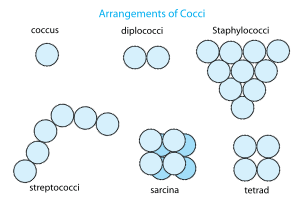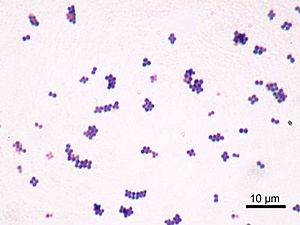Coccus facts for kids
A coccus (say "KOK-us") is a tiny living thing called a bacterium that has a round, oval, or generally spherical shape. Think of it like a tiny ball! It's one of the three main shapes that bacteria can have. The other two shapes are bacillus (which are rod-shaped, like tiny sausages) and spiral-shaped cells (which look like tiny corkscrews).
The word "coccus" comes from an old Greek word, kokkos, which means "berry." This makes sense because they look like tiny berries!
Cocci bacteria are found all around us and even inside our bodies. Some cocci are harmless or even helpful, while others can cause illnesses. Scientists study their shapes because it helps them understand how different bacteria work and how to treat infections.
Some common examples of cocci bacteria include:
- Enterococcus: Often found in our intestines.
- Neisseria: Some types can cause infections like meningitis.
- Staphylococcus: A well-known group, including Staphylococcus aureus.
- Streptococcus: Another common group, some types can cause strep throat.
Why are bacterial shapes important?
The shape of a bacterium is very important for how it lives and survives. For example, a round shape like cocci can help bacteria resist drying out or make it easier for them to float in liquids. Their shape can also affect how they move, how they attach to surfaces, and how they interact with other cells. Scientists use these shapes to help identify different types of bacteria.
How cocci group together
Cocci don't always live alone. They often stick together in different patterns, which can also help scientists identify them.
- Diplococci: These are cocci that stay in pairs, like two tiny balls stuck together.
- Streptococci: These form chains, like a string of beads.
- Staphylococci: These cluster together like a bunch of grapes.
- Tetrads: These form groups of four.
- Sarcinae: These form cube-like groups of eight.
These arrangements are often seen when scientists look at bacteria under a microscope.
Related pages
See also
 In Spanish: Coco (bacteria) para niños
In Spanish: Coco (bacteria) para niños



